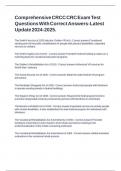Comprehensive CRCC CRC Exam Test
Questions With Correct Answers-Latest
Update 2024-2025.
The Smith-Fess Act of 1920 (aka the Civilian VR Act) - Correct answer-Considered
starting point of the public rehabilitation for people with physical disabilities; expanded
services to civilians.
The Smith-Hughes Act of 1917 - Correct answer-Provided Federal funding to states on a
matching basis for vocational education programs
The Soldier's Rehabilitation Act of 1918 - Correct answer-Authorized VR services for
World War I veterans
The Social Security Act of 1935 - Correct answer-Made the state-federal VR program
permanent
The Randolph-Sheppard Act of 1936 - Correct answer-Authorized people with blindness
to operate vending stands in federal buildings.
The Wagner-O'Day Act of 1938 - Correct answer-Required the federal government to
purchase designated products produced by persons with blindness in workshops
The Barden-LaFollette Act of 1943 - Correct answer-Expanded services to include people
with mental disabilities. It also established the state-federal program for individuals with
blindness.
The Vocational Rehabilitation Act Amendments of 1954 - Correct answer-Provided
funding to universities to train master's level rehab counselors resulting in the
professionalization of the rehab counseling profession
The Vocational Rehabilitation Act Amendment of 1965 - Correct answer-Added extended
evaluation in the vocational rehab process
,The Rehabilitation Act Amendments of 1973 - Correct answer-Mandate services for
people with severe disabilities; emphasized consumer involvement by requiring the
Individualized Written Rehabilitation Program (IWRP); and guaranteed employment rights
of people with disabilities.
Section 501 (Affirmative Action in Federal Hiring)
Section 502 (architectural and transportation barriers compliance board)
Section 503 (Affirmative Action by Federal Contract Recipient)
Section 504 (Equal Opportunities)
The Rehabilitation Act Amendments of 1978 - Correct answer-Mandated the provision of
independent living services
The Rehabilitation Act Amendments of 1984 - Correct answer-Mandated the
establishment of Client Assistance Programs
The Rehabilitation Act Amendments of 1986 - Correct answer-Added the provision of
rehabilitation engineering services and established supported employment as an
acceptable goal for rehabilitation services
The Rehabilitation Act Amendments of 1992 - Correct answer-Advanced the concepts of
empowerment, self-determination and informed choice; required state VR agencies to
establish "qualified personnel". Mandate the development of the Comprehensive System
of Personnel Development.
Presumption of ability
Career based job placement
Improving services to minority groups
Client involvement
Determining eligibility within 60 days
Order of selection
Federal share 78.7%
Rehabilitation engineering
Similar benefits
,The Rehabilitation Act Amendments of 1998 - Correct answer-Replaced the IWRP with
the Individualized Plan for Employment (IPE) to support the exercise of informed choice of
the individual in selection of the IPE's employment outcome, specific services, service
providers, and the methods to procure the services; introduced a new category of service,
namely, the provision of technical assistance and consultation to individuals to pursue
self-employment, telecommuting, or a small business operation; and transition planning
with students (can utilize VR)
Criteria to be Qualified for VR Services - Correct answer-1. Presence of a physical or
mental impairment that impedes employment 2. The person with a disability can benefit in
terms of employment outcome from VR services
The Goals of VR - Correct answer-Inclusion, opportunity, independence, empowerment,
rehabilitation, and quality of life.
The Americans with Disabilities Act of 1990 - Correct answer-A federal civil rights law
designed to prevent discrimination and enable individuals with disabilities to participate
fully in society. It includes opportunities in employment, public services, public
accommodations, telecommunications, etc.
The ADA Amendments Act (ADAAA) of 2008 - Correct answer-Overturns the
controversial Supreme Court decisions in Sutton v. United Airlines and Toyota v. Williams
- Supreme Court stated that courts should interpret the definition of "disability: strictly in
order to create a demanding standard for qualifying as disabled, denying people with
epilepsy, diabetes, cancer, HIV, and mental illness protection from disability
discrimination; The new amendment asserts that the definition of disability is intended to
be a less-demanding standard than the standard applied by the court
- Clarifies and expands the meaning and application of the definition of disability in 3
ways:
1. Provides that the definition of disability shall be constructed in favor of broad coverage
of individuals under this Act, to the maximum extent permitted by the terms of this Act
2. Prohibits consideration of mitigating measures such as medication, assistive
technology, accommodations, or modifications when determining whether an impairment
substantially limits a major life activity
3. Removes from the "regarded as" prong of the disability definition (the third prong of the
definition), the requirement that an individual demonstrates that the impairment that he or
, she has, or is perceived to have, limits a major life activity in a way that is perceived to be
substantial
- ADAAA addresses mostly Title I (employment provisions) of ADA
Disability Rights Philosophy - Correct answer-Advocacy, informed choice, and consumer
empowerment.
Individuals with Disabilities Education Act (IDEA) of 1990 - Correct answer-Ensures
students with a disability are provided with Free Appropriate Public Education that is
tailored to their individual needs.
Ticket to Work and Work Incentives Improvement Act (TWIIA) of 1999 - Correct answer-
Beneficiaries can still work and receive benefits
School-to-Work Opportunities Act (1994) - Correct answer-Federal act designed to assist
the states in building school-to-work systems that prepare students for high-skill, high-
wage jobs or future education.
CRC Code of Ethics 12 Standards - Correct answer-1. counseling Relationship 2.
Confidentiality, Privileged Communication, and Privacy 3. Advocacy and Accessibility 4.
Professional Responsibility 5. Relationships with Other Professionals 6. Forensic and
Indirect Services 7. Evaluation, Assessment, and Interpretation 8. Teaching, Supervision,
and Training 9. Research and Publication 10. Technology and Distance Counseling 11.
Business Practices 12. Resolving Ethical Issues
Ethical Principles - Correct answer-Autonomy
Beneficence (to do good)
Nonmaleficence (To do no harm)
Justice
Fidelity (to be faithful)
Veracity (to be honest)
Professional Disclosure Statement - Correct answer-Includes: 1. qualifications,
credentials, and experience of counselor 2. purpose, goal, techniques, limitations, risks,
benefits of services 3. frequency and length of services 4. confidentiality and limits of such




